Psychological Issues in Claire's Lifecycle: A Comprehensive Report
VerifiedAdded on 2022/01/07
|9
|1545
|108
Report
AI Summary
This report provides a detailed analysis of Claire's lifecycle, examining her development across various stages, from foetus to adolescence. It explores her social, emotional, cognitive, and physical development, identifying key needs at each stage and discussing how these needs can be met. The report delves into the concepts of nature versus nurture and analyzes how factors such as race, ethnicity, culture, and poverty may influence Claire's development. Furthermore, it applies relevant psychological theories, such as attachment theory and Erikson's theory of psychosocial development, to explain the dynamics of her family and situation. The report also considers the limitations of the chosen theory and discusses how it may inform professional discussions at a strategic meeting concerning Claire's future. The report concludes with recommendations for the strategic meeting based on the findings.
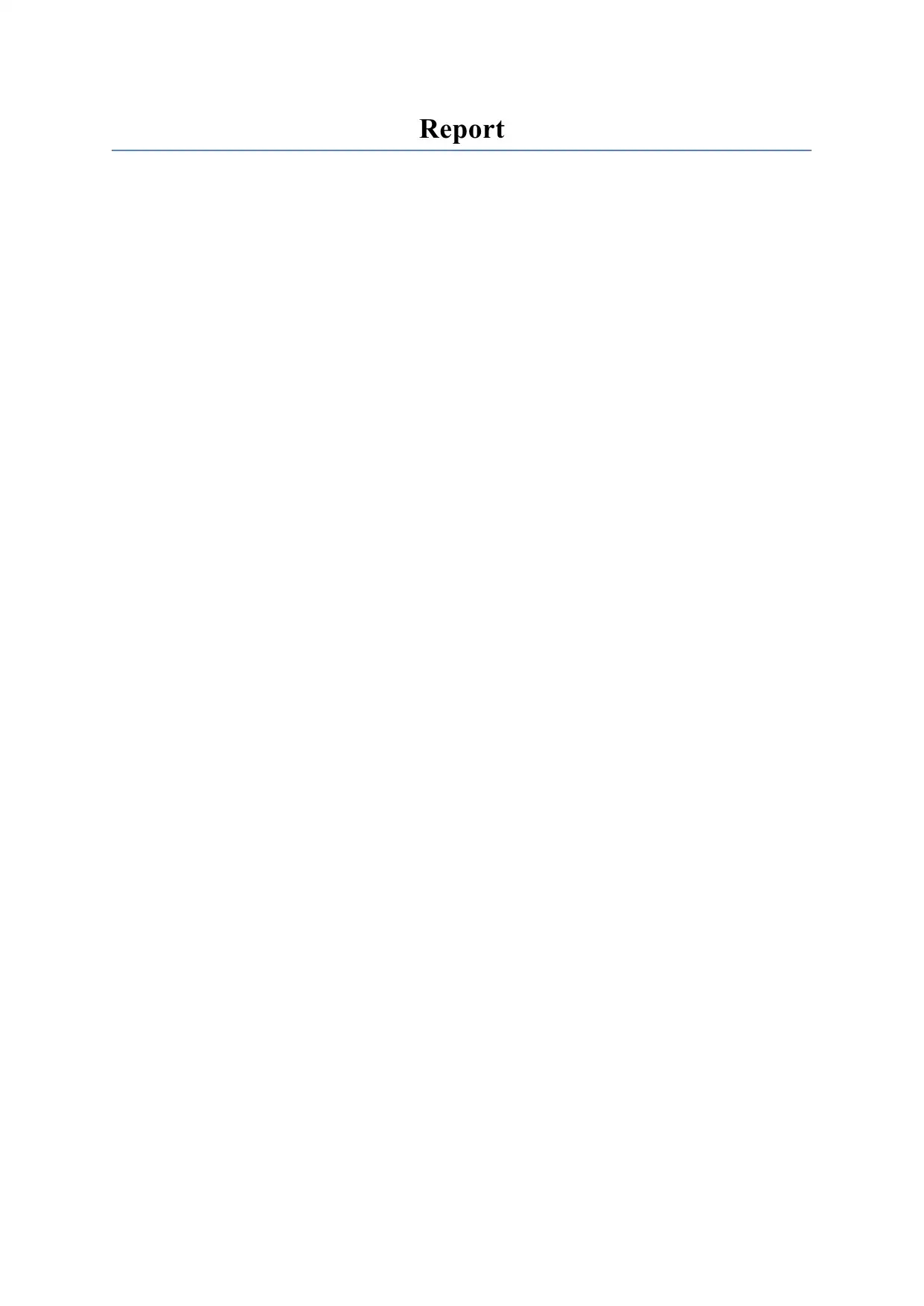
Report
Paraphrase This Document
Need a fresh take? Get an instant paraphrase of this document with our AI Paraphraser

Executive summary

Introduction 150
The stages of development that occur during the life periods of organisms can be defined as
life cycle. More than three basic stages are comprised with the lifecycle of the individuals
globally (Vemuri et al., 2018). Healthy psychological situation in the lives of the individuals
are essential because through reproduction, the human beings make rise of new generation
during the adult stage of life (martleshamacademy.org, 2021). The report aims to explore the
way; the psychological issues that can be identified in the case study on situation of Claire’s
life can be addressed. Therefore, the report will discuss the different stages of lifecycle, the
way different needs of Claire can be fulfilled at the different stage of her lifecycle and the
way theories of lifecycle development can be followed to bring improvement in Claire’s
lifecycle.
Task 1. Discuss the different stages of the lifecycle 650
Lifecycle development can be defined as the stages of life among the individuals where
different types of issues arrive in front of the individuals. In the process of lifecycle the
individuals to be in the next stage of life address development issues of each of the stages
(Assal and Chiasson, 2018). In every stage, the state of psychological situation is different
among the individuals and mitigation of issues of each stage lead the individual towards the
development of next stage.
-Identify each stage of Claire’s lifecycle to date including her social, emotional,
cognitive, and physical development within each of her life stages of
development 500
Like every individuals multiple stages are associated with the life of Claire. A healthy life
style through fulfilment of basic needs can lead make Claire a healthy child in terms of
personal as well as professional development in her further future life. Throughout the life of
Claire, following are the stages she has gone and will have to go through:
Foetus
Being a child of human beings the life of Claire has been started from her mother’s belly as
foetus. According to the biological theories, Claire has started growing from her mother’s
belly in the worm that was surrounded by liquid (De Kovel et al., 2018). During growing in
The stages of development that occur during the life periods of organisms can be defined as
life cycle. More than three basic stages are comprised with the lifecycle of the individuals
globally (Vemuri et al., 2018). Healthy psychological situation in the lives of the individuals
are essential because through reproduction, the human beings make rise of new generation
during the adult stage of life (martleshamacademy.org, 2021). The report aims to explore the
way; the psychological issues that can be identified in the case study on situation of Claire’s
life can be addressed. Therefore, the report will discuss the different stages of lifecycle, the
way different needs of Claire can be fulfilled at the different stage of her lifecycle and the
way theories of lifecycle development can be followed to bring improvement in Claire’s
lifecycle.
Task 1. Discuss the different stages of the lifecycle 650
Lifecycle development can be defined as the stages of life among the individuals where
different types of issues arrive in front of the individuals. In the process of lifecycle the
individuals to be in the next stage of life address development issues of each of the stages
(Assal and Chiasson, 2018). In every stage, the state of psychological situation is different
among the individuals and mitigation of issues of each stage lead the individual towards the
development of next stage.
-Identify each stage of Claire’s lifecycle to date including her social, emotional,
cognitive, and physical development within each of her life stages of
development 500
Like every individuals multiple stages are associated with the life of Claire. A healthy life
style through fulfilment of basic needs can lead make Claire a healthy child in terms of
personal as well as professional development in her further future life. Throughout the life of
Claire, following are the stages she has gone and will have to go through:
Foetus
Being a child of human beings the life of Claire has been started from her mother’s belly as
foetus. According to the biological theories, Claire has started growing from her mother’s
belly in the worm that was surrounded by liquid (De Kovel et al., 2018). During growing in
⊘ This is a preview!⊘
Do you want full access?
Subscribe today to unlock all pages.

Trusted by 1+ million students worldwide
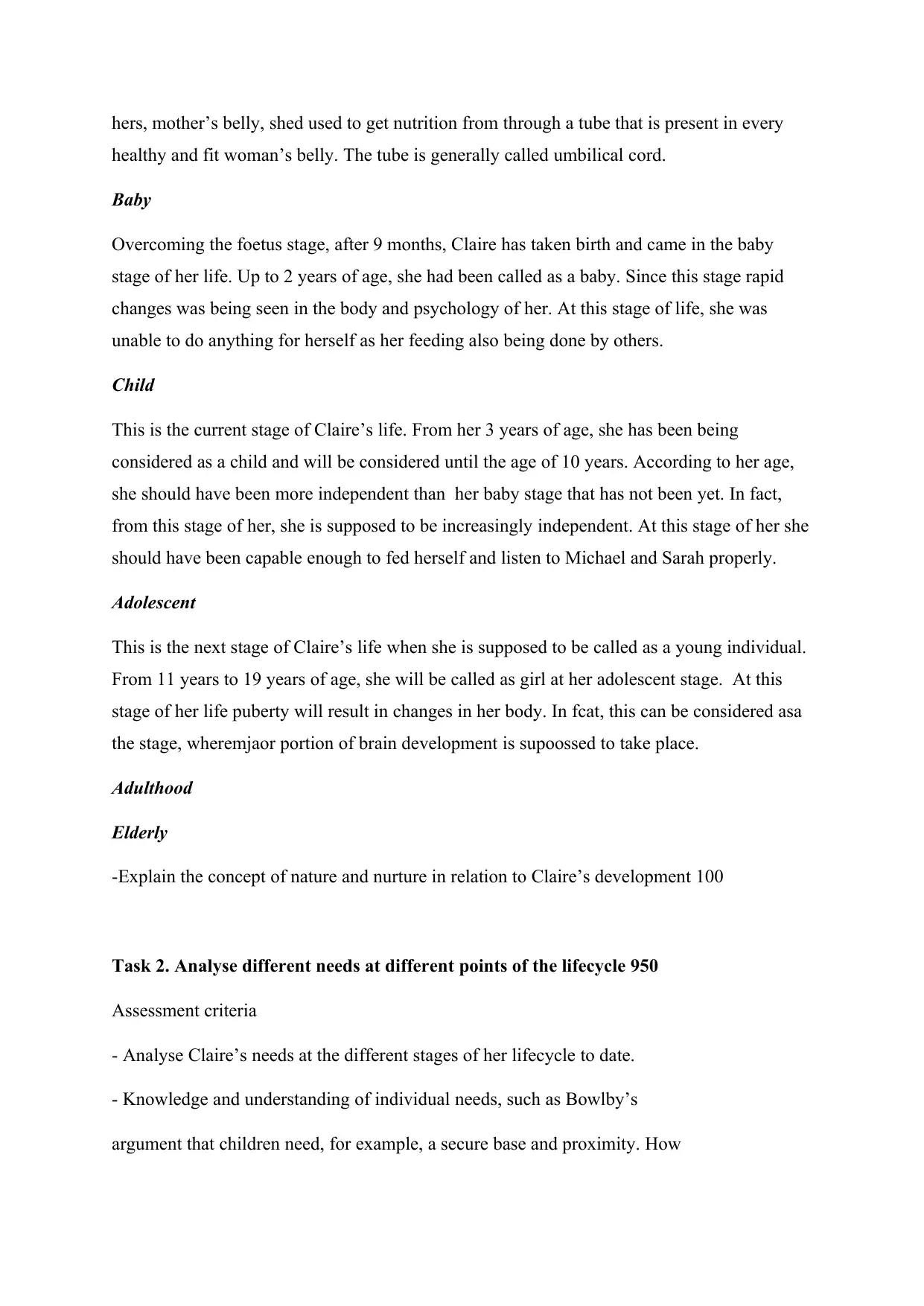
hers, mother’s belly, shed used to get nutrition from through a tube that is present in every
healthy and fit woman’s belly. The tube is generally called umbilical cord.
Baby
Overcoming the foetus stage, after 9 months, Claire has taken birth and came in the baby
stage of her life. Up to 2 years of age, she had been called as a baby. Since this stage rapid
changes was being seen in the body and psychology of her. At this stage of life, she was
unable to do anything for herself as her feeding also being done by others.
Child
This is the current stage of Claire’s life. From her 3 years of age, she has been being
considered as a child and will be considered until the age of 10 years. According to her age,
she should have been more independent than her baby stage that has not been yet. In fact,
from this stage of her, she is supposed to be increasingly independent. At this stage of her she
should have been capable enough to fed herself and listen to Michael and Sarah properly.
Adolescent
This is the next stage of Claire’s life when she is supposed to be called as a young individual.
From 11 years to 19 years of age, she will be called as girl at her adolescent stage. At this
stage of her life puberty will result in changes in her body. In fcat, this can be considered asa
the stage, wheremjaor portion of brain development is supoossed to take place.
Adulthood
Elderly
-Explain the concept of nature and nurture in relation to Claire’s development 100
Task 2. Analyse different needs at different points of the lifecycle 950
Assessment criteria
- Analyse Claire’s needs at the different stages of her lifecycle to date.
- Knowledge and understanding of individual needs, such as Bowlby’s
argument that children need, for example, a secure base and proximity. How
healthy and fit woman’s belly. The tube is generally called umbilical cord.
Baby
Overcoming the foetus stage, after 9 months, Claire has taken birth and came in the baby
stage of her life. Up to 2 years of age, she had been called as a baby. Since this stage rapid
changes was being seen in the body and psychology of her. At this stage of life, she was
unable to do anything for herself as her feeding also being done by others.
Child
This is the current stage of Claire’s life. From her 3 years of age, she has been being
considered as a child and will be considered until the age of 10 years. According to her age,
she should have been more independent than her baby stage that has not been yet. In fact,
from this stage of her, she is supposed to be increasingly independent. At this stage of her she
should have been capable enough to fed herself and listen to Michael and Sarah properly.
Adolescent
This is the next stage of Claire’s life when she is supposed to be called as a young individual.
From 11 years to 19 years of age, she will be called as girl at her adolescent stage. At this
stage of her life puberty will result in changes in her body. In fcat, this can be considered asa
the stage, wheremjaor portion of brain development is supoossed to take place.
Adulthood
Elderly
-Explain the concept of nature and nurture in relation to Claire’s development 100
Task 2. Analyse different needs at different points of the lifecycle 950
Assessment criteria
- Analyse Claire’s needs at the different stages of her lifecycle to date.
- Knowledge and understanding of individual needs, such as Bowlby’s
argument that children need, for example, a secure base and proximity. How
Paraphrase This Document
Need a fresh take? Get an instant paraphrase of this document with our AI Paraphraser
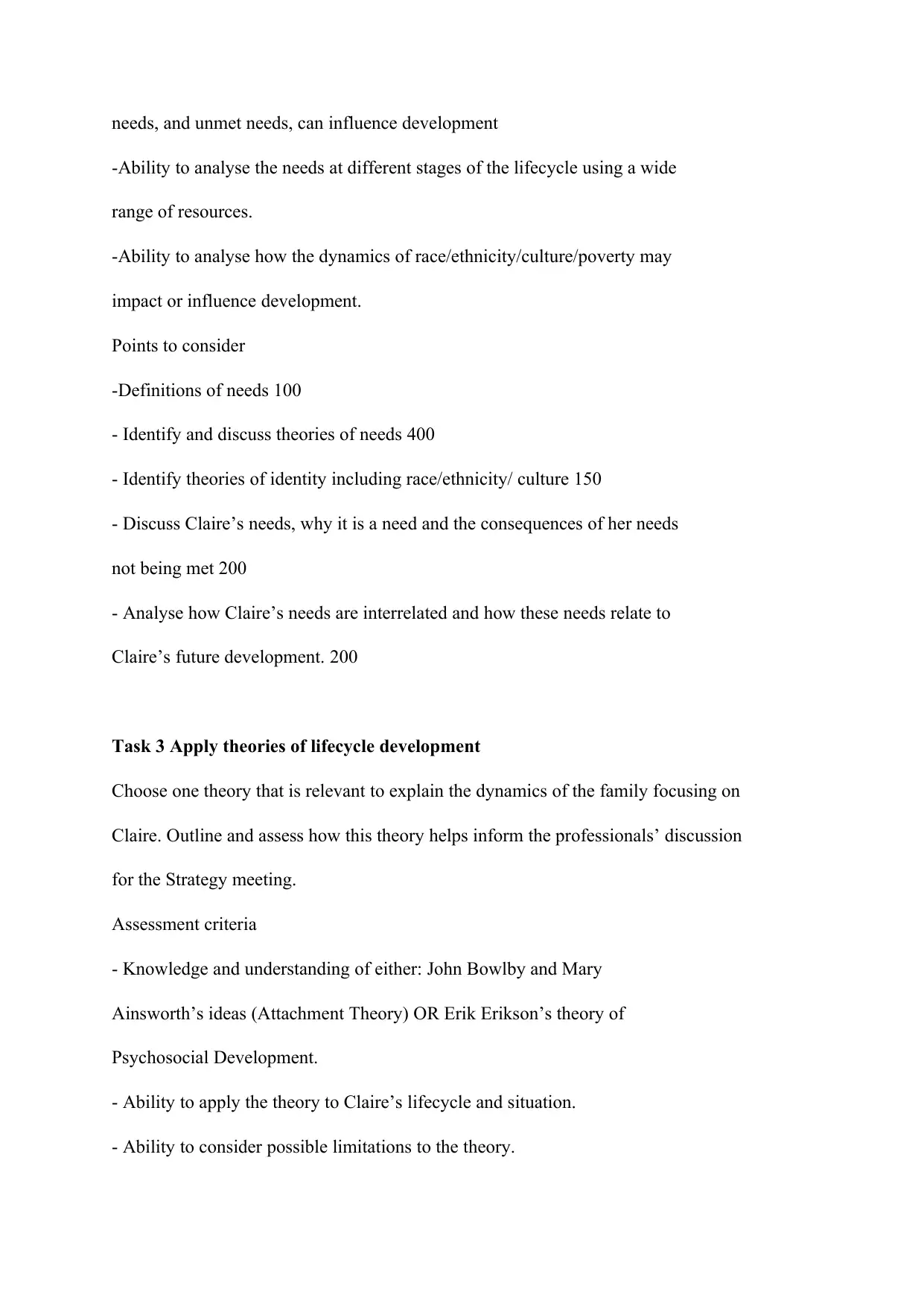
needs, and unmet needs, can influence development
-Ability to analyse the needs at different stages of the lifecycle using a wide
range of resources.
-Ability to analyse how the dynamics of race/ethnicity/culture/poverty may
impact or influence development.
Points to consider
-Definitions of needs 100
- Identify and discuss theories of needs 400
- Identify theories of identity including race/ethnicity/ culture 150
- Discuss Claire’s needs, why it is a need and the consequences of her needs
not being met 200
- Analyse how Claire’s needs are interrelated and how these needs relate to
Claire’s future development. 200
Task 3 Apply theories of lifecycle development
Choose one theory that is relevant to explain the dynamics of the family focusing on
Claire. Outline and assess how this theory helps inform the professionals’ discussion
for the Strategy meeting.
Assessment criteria
- Knowledge and understanding of either: John Bowlby and Mary
Ainsworth’s ideas (Attachment Theory) OR Erik Erikson’s theory of
Psychosocial Development.
- Ability to apply the theory to Claire’s lifecycle and situation.
- Ability to consider possible limitations to the theory.
-Ability to analyse the needs at different stages of the lifecycle using a wide
range of resources.
-Ability to analyse how the dynamics of race/ethnicity/culture/poverty may
impact or influence development.
Points to consider
-Definitions of needs 100
- Identify and discuss theories of needs 400
- Identify theories of identity including race/ethnicity/ culture 150
- Discuss Claire’s needs, why it is a need and the consequences of her needs
not being met 200
- Analyse how Claire’s needs are interrelated and how these needs relate to
Claire’s future development. 200
Task 3 Apply theories of lifecycle development
Choose one theory that is relevant to explain the dynamics of the family focusing on
Claire. Outline and assess how this theory helps inform the professionals’ discussion
for the Strategy meeting.
Assessment criteria
- Knowledge and understanding of either: John Bowlby and Mary
Ainsworth’s ideas (Attachment Theory) OR Erik Erikson’s theory of
Psychosocial Development.
- Ability to apply the theory to Claire’s lifecycle and situation.
- Ability to consider possible limitations to the theory.
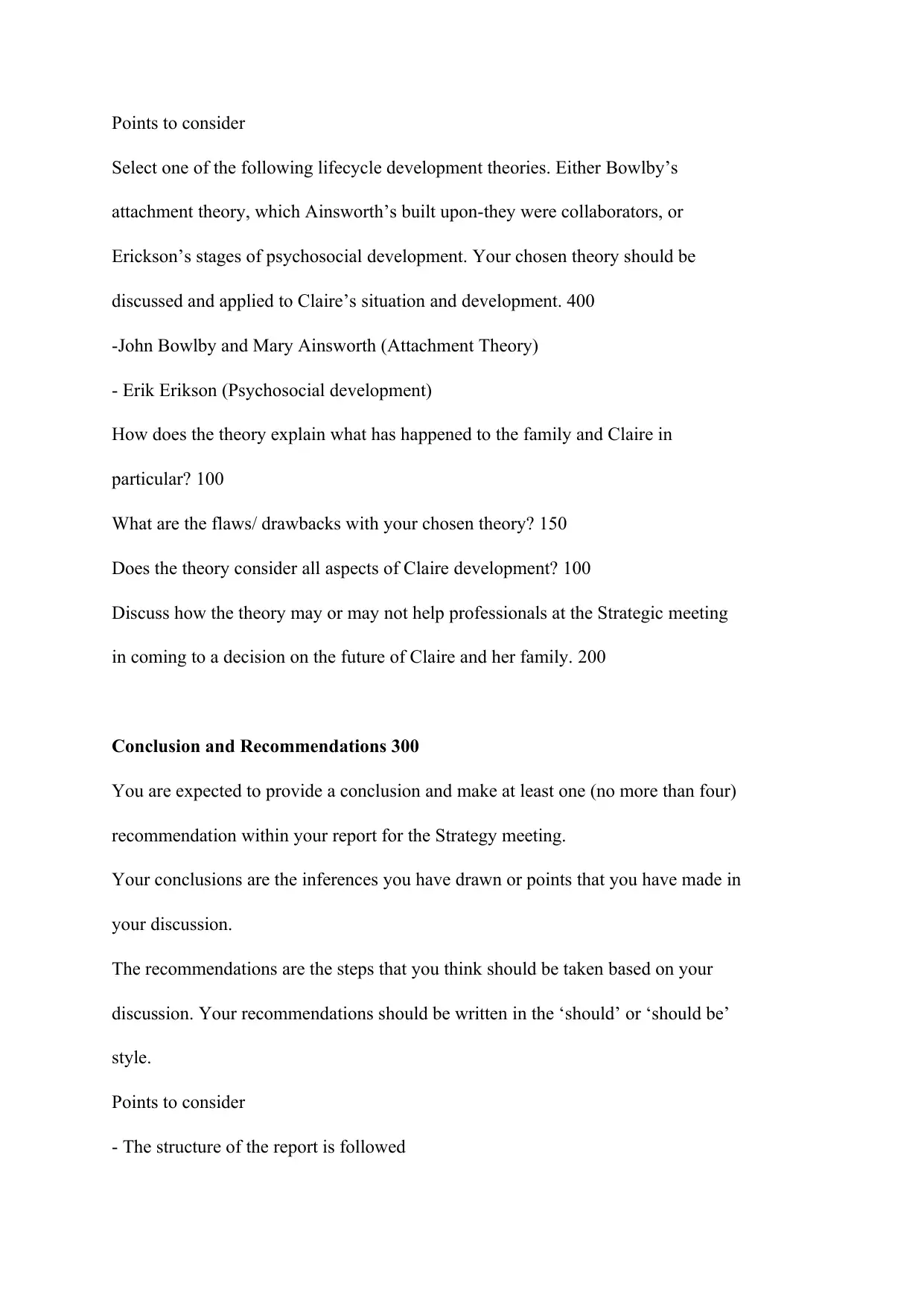
Points to consider
Select one of the following lifecycle development theories. Either Bowlby’s
attachment theory, which Ainsworth’s built upon-they were collaborators, or
Erickson’s stages of psychosocial development. Your chosen theory should be
discussed and applied to Claire’s situation and development. 400
-John Bowlby and Mary Ainsworth (Attachment Theory)
- Erik Erikson (Psychosocial development)
How does the theory explain what has happened to the family and Claire in
particular? 100
What are the flaws/ drawbacks with your chosen theory? 150
Does the theory consider all aspects of Claire development? 100
Discuss how the theory may or may not help professionals at the Strategic meeting
in coming to a decision on the future of Claire and her family. 200
Conclusion and Recommendations 300
You are expected to provide a conclusion and make at least one (no more than four)
recommendation within your report for the Strategy meeting.
Your conclusions are the inferences you have drawn or points that you have made in
your discussion.
The recommendations are the steps that you think should be taken based on your
discussion. Your recommendations should be written in the ‘should’ or ‘should be’
style.
Points to consider
- The structure of the report is followed
Select one of the following lifecycle development theories. Either Bowlby’s
attachment theory, which Ainsworth’s built upon-they were collaborators, or
Erickson’s stages of psychosocial development. Your chosen theory should be
discussed and applied to Claire’s situation and development. 400
-John Bowlby and Mary Ainsworth (Attachment Theory)
- Erik Erikson (Psychosocial development)
How does the theory explain what has happened to the family and Claire in
particular? 100
What are the flaws/ drawbacks with your chosen theory? 150
Does the theory consider all aspects of Claire development? 100
Discuss how the theory may or may not help professionals at the Strategic meeting
in coming to a decision on the future of Claire and her family. 200
Conclusion and Recommendations 300
You are expected to provide a conclusion and make at least one (no more than four)
recommendation within your report for the Strategy meeting.
Your conclusions are the inferences you have drawn or points that you have made in
your discussion.
The recommendations are the steps that you think should be taken based on your
discussion. Your recommendations should be written in the ‘should’ or ‘should be’
style.
Points to consider
- The structure of the report is followed
⊘ This is a preview!⊘
Do you want full access?
Subscribe today to unlock all pages.

Trusted by 1+ million students worldwide
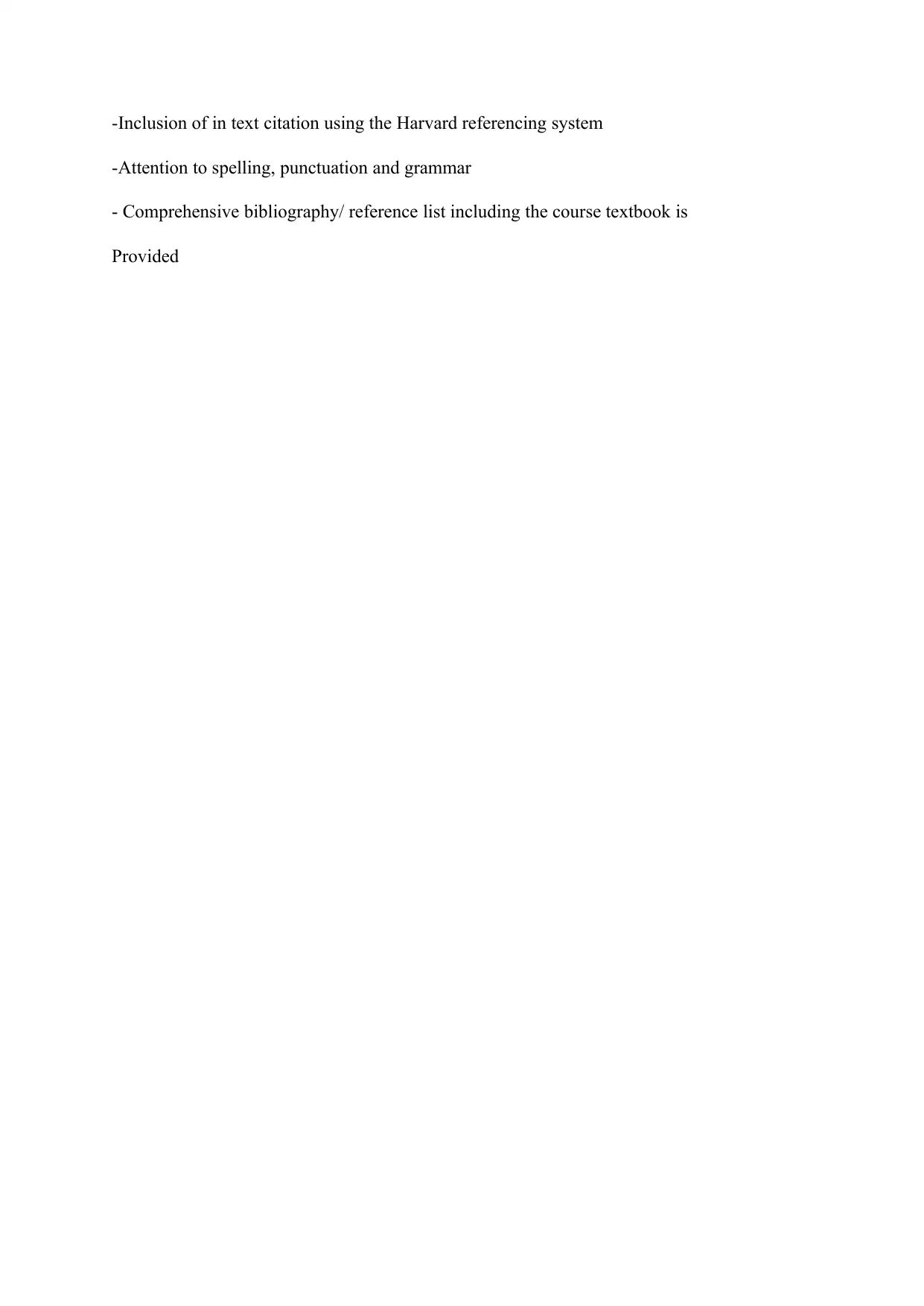
-Inclusion of in text citation using the Harvard referencing system
-Attention to spelling, punctuation and grammar
- Comprehensive bibliography/ reference list including the course textbook is
Provided
-Attention to spelling, punctuation and grammar
- Comprehensive bibliography/ reference list including the course textbook is
Provided
Paraphrase This Document
Need a fresh take? Get an instant paraphrase of this document with our AI Paraphraser
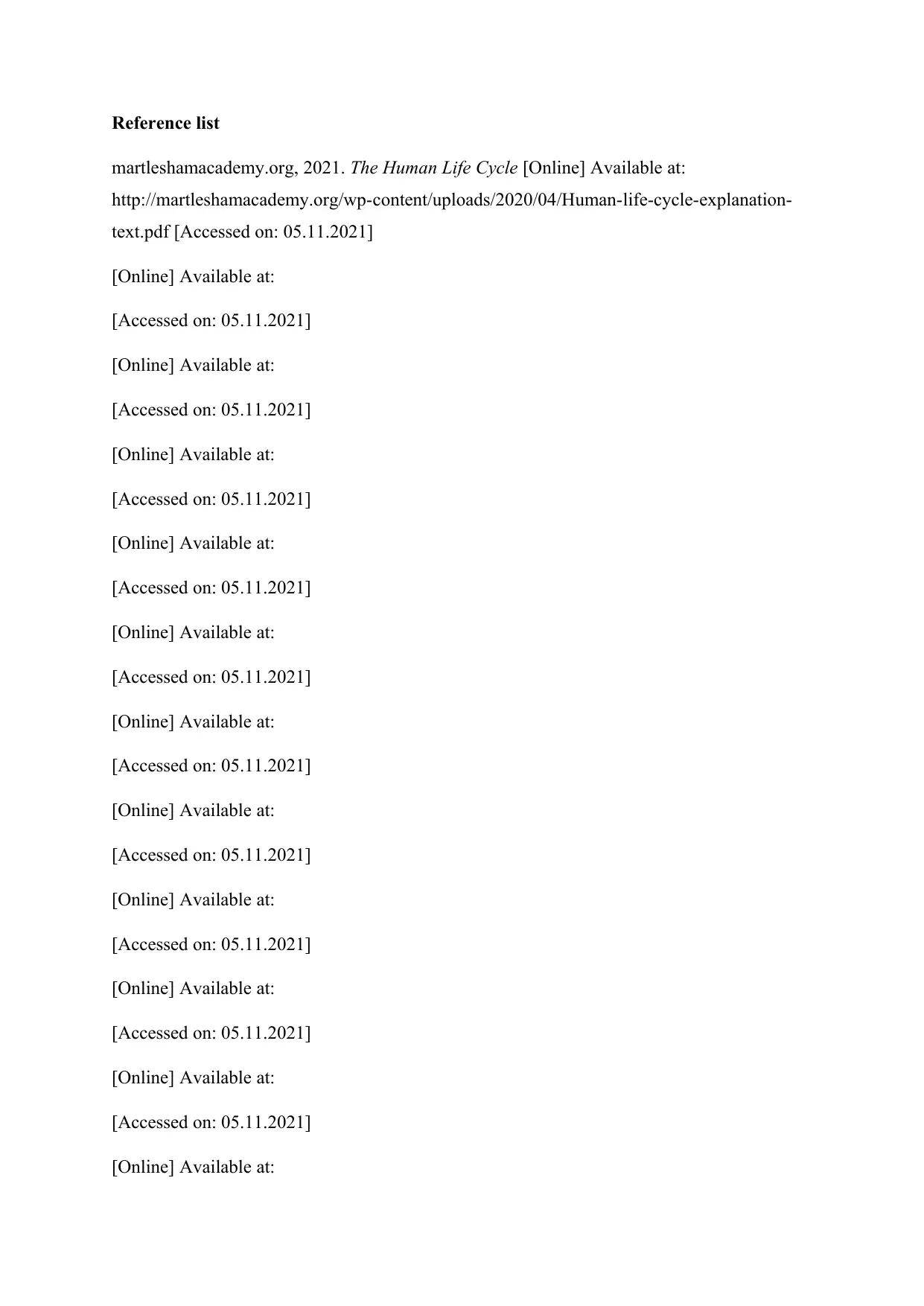
Reference list
martleshamacademy.org, 2021. The Human Life Cycle [Online] Available at:
http://martleshamacademy.org/wp-content/uploads/2020/04/Human-life-cycle-explanation-
text.pdf [Accessed on: 05.11.2021]
[Online] Available at:
[Accessed on: 05.11.2021]
[Online] Available at:
[Accessed on: 05.11.2021]
[Online] Available at:
[Accessed on: 05.11.2021]
[Online] Available at:
[Accessed on: 05.11.2021]
[Online] Available at:
[Accessed on: 05.11.2021]
[Online] Available at:
[Accessed on: 05.11.2021]
[Online] Available at:
[Accessed on: 05.11.2021]
[Online] Available at:
[Accessed on: 05.11.2021]
[Online] Available at:
[Accessed on: 05.11.2021]
[Online] Available at:
[Accessed on: 05.11.2021]
[Online] Available at:
martleshamacademy.org, 2021. The Human Life Cycle [Online] Available at:
http://martleshamacademy.org/wp-content/uploads/2020/04/Human-life-cycle-explanation-
text.pdf [Accessed on: 05.11.2021]
[Online] Available at:
[Accessed on: 05.11.2021]
[Online] Available at:
[Accessed on: 05.11.2021]
[Online] Available at:
[Accessed on: 05.11.2021]
[Online] Available at:
[Accessed on: 05.11.2021]
[Online] Available at:
[Accessed on: 05.11.2021]
[Online] Available at:
[Accessed on: 05.11.2021]
[Online] Available at:
[Accessed on: 05.11.2021]
[Online] Available at:
[Accessed on: 05.11.2021]
[Online] Available at:
[Accessed on: 05.11.2021]
[Online] Available at:
[Accessed on: 05.11.2021]
[Online] Available at:
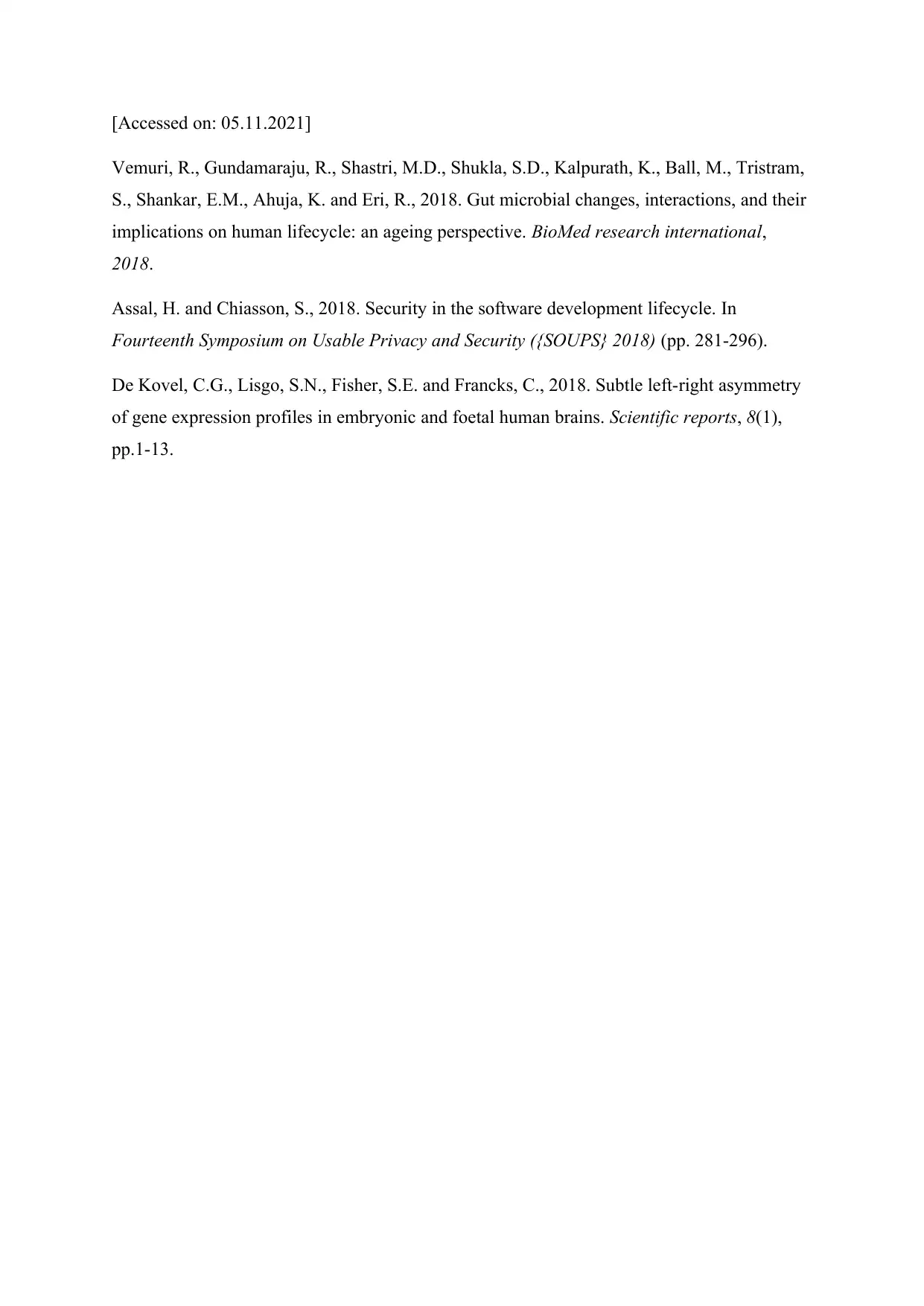
[Accessed on: 05.11.2021]
Vemuri, R., Gundamaraju, R., Shastri, M.D., Shukla, S.D., Kalpurath, K., Ball, M., Tristram,
S., Shankar, E.M., Ahuja, K. and Eri, R., 2018. Gut microbial changes, interactions, and their
implications on human lifecycle: an ageing perspective. BioMed research international,
2018.
Assal, H. and Chiasson, S., 2018. Security in the software development lifecycle. In
Fourteenth Symposium on Usable Privacy and Security ({SOUPS} 2018) (pp. 281-296).
De Kovel, C.G., Lisgo, S.N., Fisher, S.E. and Francks, C., 2018. Subtle left-right asymmetry
of gene expression profiles in embryonic and foetal human brains. Scientific reports, 8(1),
pp.1-13.
Vemuri, R., Gundamaraju, R., Shastri, M.D., Shukla, S.D., Kalpurath, K., Ball, M., Tristram,
S., Shankar, E.M., Ahuja, K. and Eri, R., 2018. Gut microbial changes, interactions, and their
implications on human lifecycle: an ageing perspective. BioMed research international,
2018.
Assal, H. and Chiasson, S., 2018. Security in the software development lifecycle. In
Fourteenth Symposium on Usable Privacy and Security ({SOUPS} 2018) (pp. 281-296).
De Kovel, C.G., Lisgo, S.N., Fisher, S.E. and Francks, C., 2018. Subtle left-right asymmetry
of gene expression profiles in embryonic and foetal human brains. Scientific reports, 8(1),
pp.1-13.
⊘ This is a preview!⊘
Do you want full access?
Subscribe today to unlock all pages.

Trusted by 1+ million students worldwide
1 out of 9
Related Documents
Your All-in-One AI-Powered Toolkit for Academic Success.
+13062052269
info@desklib.com
Available 24*7 on WhatsApp / Email
![[object Object]](/_next/static/media/star-bottom.7253800d.svg)
Unlock your academic potential
Copyright © 2020–2025 A2Z Services. All Rights Reserved. Developed and managed by ZUCOL.
![Case Study: Moral Status of Fetal Abnormality - Course ID [Intro]](/_next/image/?url=https%3A%2F%2Fdesklib.com%2Fmedia%2Fimages%2Fpr%2F8aa0e2425c0e41d9a2d0f13fb6258e83.jpg&w=256&q=75)




